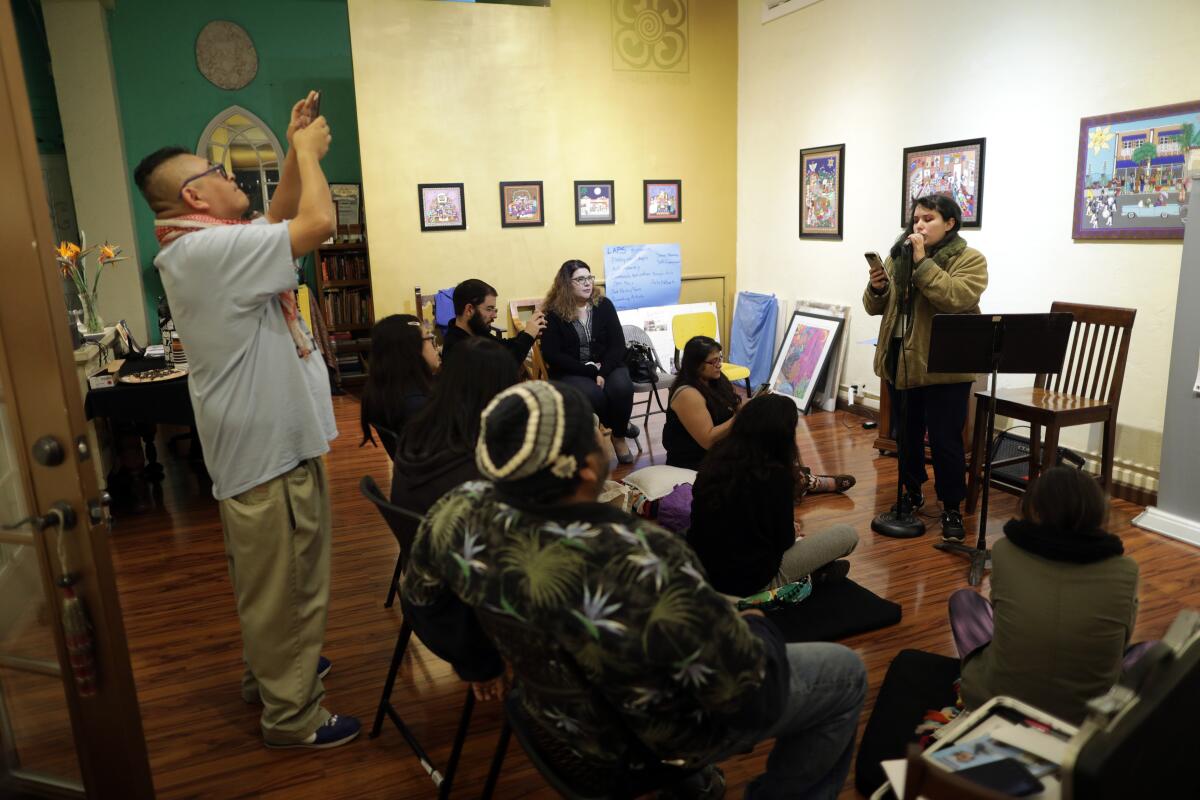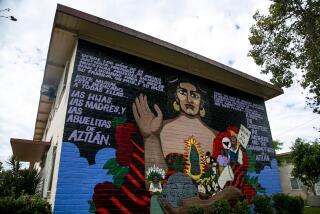Dryland, a literary journal based in South-Central, tells stories that are often left out

- Share via
It’s hard for poet Daniel Morales Leon, 38, who works as a cook at a coffee shop in the Arts District, to think of himself as an artist with a capital A.
He’d be more comfortable with the title of deviant or drunkard. He smokes a lot of weed, sometimes drinks too much and worries that he is disappointing his mother. He took a lot of creative writing classes in community college but he failed them all.
Tattoos cover his body, and some of his fingers have lost feeling from the time he was shot and robbed in front of his family home in West Adams. On his forehead, two scars form the partial outline of a bike pedal, a souvenir from a bar fight. (He didn’t say much about the fight, but he did confirm that the pedal was still attached to the bike when it gave him the scar.)
But he’s always been drawn to art and literature. His tattoos depict literary heroes like Edgar Allan Poe, John Fante, Albert Camus and Jorge Luis Borges. His left forearm bears the inked words of a Cuban revolutionary: “Before I die I want to recite the verses from my soul.”
Leon is exactly the type of artist that Dryland, a literary journal based in South-Central Los Angeles, is looking for, said the journal’s founder, Viva Padilla. For the last four years, Dryland has published writers and artists from a variety of backgrounds, expressing a literary perspective based on the experiences of people born and raised in South-Central Los Angeles.
A piece by assistant editor and South-Central native Nikolai Garcia finds beauty in the way the sun shines down on a concrete block where a crowd of middle-schoolers have gathered to witness a fight. A verse by Edward Vidaurre uncovers poetry in the smooth efficiency of a quick, quiet robbery at knifepoint during a Metro bus stop, the perpetrator melting silently into the crowd of exiting passengers. A Tongva poet, Megan Dorame, wrote of a grove of orange trees planted over a mass grave outside a mission.
“And when the trees bore fruit / I wonder / was it boiled down, and mixed with sugar / for jam? Did the padres spread it over bread?” wrote Dorame.
Padilla started the journal because she wanted the neighborhood she grew up in to have a literary outlet. Being from South-Central has often made her feel like an outsider in literary circles, and the journal helps her find other artists who felt the same disconnect. The title is a play on T.S. Eliot’s poem “The Waste Land.”
“We’re saying that [South-Central] isn’t a wasteland. It’s dry land, and it just needs to be watered. There’s life there that needs to be brought to the surface,” Padilla said.
Many of the journal’s contributors have day jobs and no interest in obtaining art degrees, or the debt that comes with them. Padilla works a day job at a record store in Boyle Heights, and Garcia answers phones at a nonprofit in Skid Row.
“I feel like I’ve gotten an MFA in the streets,” Padilla said.
Dryland caught my attention because in a big city like Los Angeles, neighborhoods rarely get to tell their own stories. The writers that make it to the institutions that inevitably shape narratives of the city aren’t often local voices — this Michigan-born, Tennessee-raised columnist included. And in a lot of artistic professions, the content of your art is supposed to matter more than where you’re from or who you are.
But where you’re from matters, especially for Dryland and the artists contributing to it. Not all of them are from South-Central or even Los Angeles. But many of them grew up with the nagging sensation that their stories and experiences were left out of mainstream narratives and institutions.
“People focus on the fruit, but the fruit is attached to roots,” said SondriaWrites, a writer and contributor from the Inland Empire. “People like to big-up the fruit, but they don’t care about the roots. But the roots matter.”
The journal never makes these explicit critiques of institutions and canons and establishments. But it shows how narrow mainstream perspectives can be by focusing on the vastness of what’s left out.
And for many of the artists, the validation of being published in a literary journal next to established artists is important and rare. At a Dryland release party earlier this year, Leon read his poetry on a lineup that included artist Harry Gamboa Jr., who contributed a short story to Issue 9.
“The highlight of my year,” Leon said.
Padilla, a native of Chesterfield Square, was born Anna Urena and raised near the intersection of Western and Slauson avenues. Her father, Roberto Urena, was a mariachi recording artist who quit music to find steady work as a plumber and car salesman after becoming a father. She didn’t grow up thinking she was going to be an artist.
“I was more thinking like, how ... am I going to get out of here?” Padilla said.
But her father, the musical director at the church, was always playing guitar and singing. She read all the books she could get her hands on, hung out at the library a lot and got into theater. She credits her father for her first literary experiences. He often made the family of eight assemble around the dinner table and read passages from the Bible, forcing them to think critically about what they had read.
Before her father died, Padilla walked more of a traditional literary path. She published her first zine in college and got interested in magazines. She took an internship at the Los Angeles Times and worked on an early version of www.latimes.com, updating databases.
But then her father died, and her family began to struggle financially. She moved out, and kept having to switch apartments to stay afloat, like “a ship with no anchor.”
She dyed her hair green, and shaved it all off, twice. She ran a zine for an anarchist collective that met in a warehouse. She led multigenerational writing workshops and organized open mics at the South-Central Healing Art Space, but the space closed after two years. She started a poetry podcast. She went to open mics and hip-hop nights. And in 2012, she had a son.
Around that time, she started going by Viva Padilla. Padilla is the last name of her grandmother, who grew up in Mexico with her own unrealized writing ambitions. Viva was about reclaiming life, and enshrining her emergence from a long struggle with depression.
Starting the magazine helped her fight a kind of malaise that had taken hold after her father’s death. She edited all the pieces, designed each page, sold ads, and recruited new writers and poets.
She met a lot of contributors at small, local open mics — the kind where poets tend to print their own books and don’t mind if you’re buying them to read or roll a joint on.
Many of the writers she recruited didn’t know if their work was meaningful enough to include in a journal. Padilla told them that it was.
“It’s not about showing off fancy techniques. It’s about connecting, an equality between reader and writer,” Padilla said.
She’s come to see the journal as not just an affirming literary space for underrepresented artists, but also a portal from South-Central Los Angeles to the mainstream literary world. Dorame, the Tongva poet, was recently awarded the Emerging Voices fellowship from Pen America. Artistic spaces across the city like Amoeba Music in Hollywood and the Museum of Contemporary Art in Los Angeles now stock the journal.
But Garcia, who last year became the journal’s assistant editor, says the journal sells best in the neighborhoods it was created for. Coffee shops in Compton, Boyle Heights and Highland Park restock the journal more often than anywhere else.
“We’ve always been creative and we’ve always had something to say,” Padilla said. “This is our way to inform people of that.”
More to Read
Sign up for Essential California
The most important California stories and recommendations in your inbox every morning.
You may occasionally receive promotional content from the Los Angeles Times.











